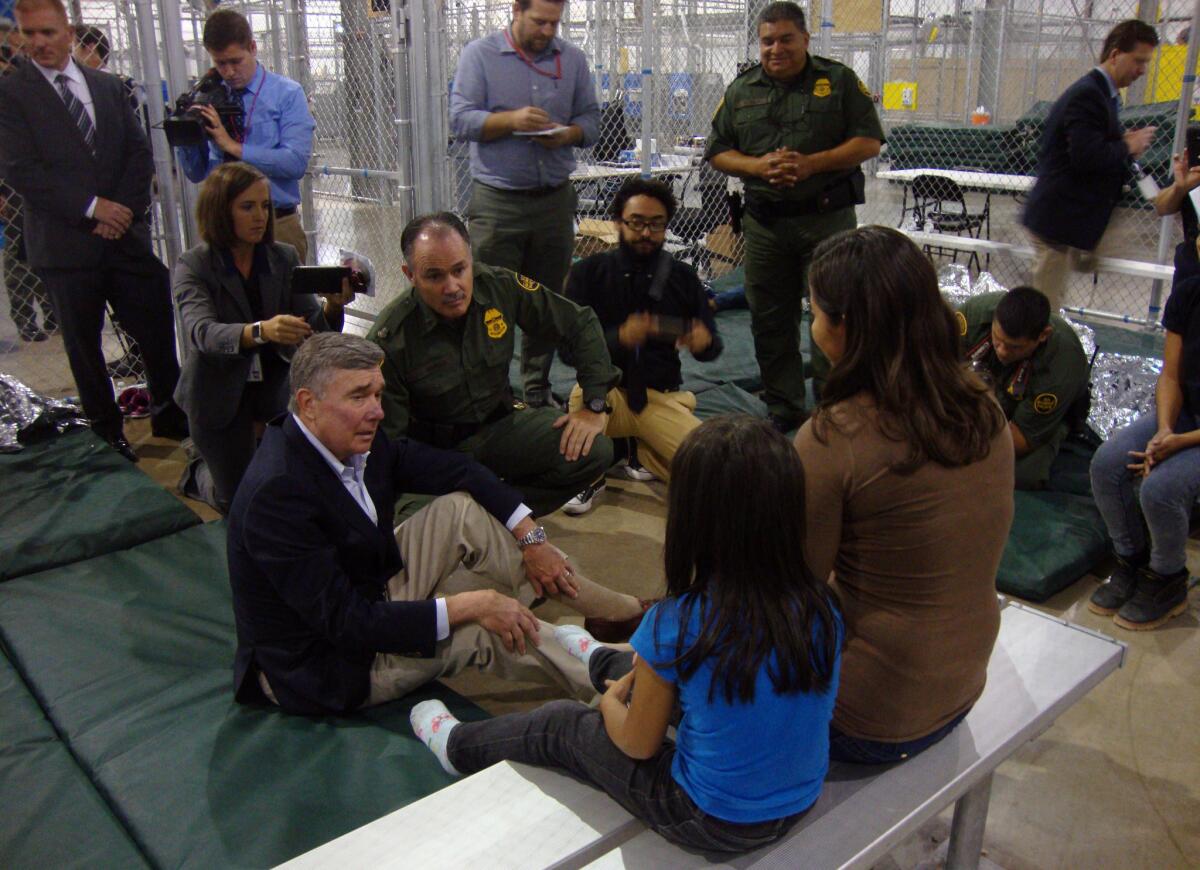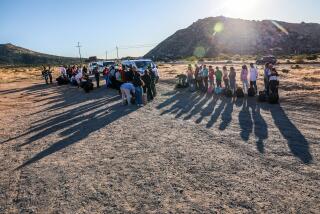Border Patrol chief visits Texas and warns immigrants of deportation

Border Patrol Commissioner R. Gil Kerlikowske, left, talks with a Salvadoran mother and her 6-year-old twins with the help of a Border Patrol agent’s translation. Kerlikowske visited the processing center in McAllen, Texas, on Wednesday in an attempt to deter people from crossing the border.
Reporting from McAllen, Texas — The Border Patrol’s top official visited an immigrant processing center in a converted warehouse Wednesday to promote a public awareness campaign aimed at preventing Central American immigrants from ending up in this border city.
As he stood flanked by immigration and Central American consular officials, Customs and Border Protection Commissioner R. Gil Kerlikowske recalled visiting here a week after his swearing-in in March 2014, before the center in McAllen opened.
The nearby Border Patrol station was overwhelmed by an influx of Central Americans last summer, many of them mothers and children. “There was not a square foot of that station where we didn’t have kids sleeping,” Kerlikowske said of the facility.
He spoke as he stood inside the massive processing center, divided by chain-link fence into holding areas. It was a stark contrast to where immigrants were held last summer, cells that were grimy, reeked of body odor and lacked food, bedding and other basic supplies, especially for children. Immigrants were so cold, they nicknamed the cells hieleras, or freezers.
This processing center opened in July 2014 with room for up to 1,500 adults and children. The Border Patrol has improved transportation, food and medical services, Kerlikowske said.
When he arrived Wednesday morning, he passed a nurse practitioner, youths watching cartoons on a ceiling television, mothers feeding babies formula and shelves stacked with diapers and clothing sorted by size. The cavernous building was air conditioned, many of the immigrants were in short sleeves and had wrapped themselves in silvery Mylar blankets, but did not appear cold.
“We’re in a much better position now,” Kerlikowske said, but, “what we would much rather do is prevent this.”
Last summer, McAllen was the epicenter of the Central American immigrant influx, and the surrounding Rio Grande Valley is still the busiest spot for illegal crossings on the southern border. Kerlikowske noted that illegal crossings have dropped dramatically since last summer, especially by unaccompanied minors and families, which are down by more than half compared to this time last summer. On Wednesday, the center was holding about 250 adults and children.
But Border Patrol officials said they have seen a slight increase this month and last, and are now apprehending about 400 people a day. Kerlikowske said that’s troubling.
“We’re watching those numbers very carefully,” he said, adding, “We’re concerned.”
So far this fiscal year, Kerlikowske said, the Border Patrol has rescued 1,100 immigrants who were in distress and recovered 90 immigrants’ remains. Among those who died near here this month: an 11-year-old Salvadoran boy, overcome by dehydration and exhaustion soon after crossing the border.
“You have to have a heart of stone not to appreciate what they’ve been through and why they came to this country,” he said of immigrants.
Kerlikowske said detention alone is not enough to stop immigrants from crossing the southern border illegally, fleeing violence and deteriorating economies. That’s why Customs and Border Protection launched the “Know the Facts” radio and print campaign in Guatemala, Honduras and El Salvador to dispel rumors and alert would-be immigrants that those who arrive after January 2014 “are priorities for deportation, regardless of age.”
The agency will also promote the campaign in Los Angeles and other major U.S. cities, he said, with polling afterward to gauge their success.
He noted that President Obama has also asked Congress to provide $1 billion in additional aid to Guatemala, Honduras and El Salvador to prevent immigrants from leaving.
He declined to comment about the fate of the country’s three immigrant family detention centers, which are run by U.S. Immigration and Customs Enforcement. Last week, a federal judge in Los Angeles ruled that the administration would have to release children because conditions at the centers violate a 1997 court settlement.
Kerlikowske said more immigration judges need to be added to address a backlog of cases, as well as more staff to process immigrants’ asylum claims, proposals the administration has backed.
Among those Kerlikowske stopped to talk to in one of the fenced-off holding areas was a ponytailed young Salvadoran mother sitting on a metal bench with her 6-year-old twins, a boy and a girl. They were surrounded by about a dozen mothers and children, some sleeping on green pallets.
As Border Patrol agents looked on, he sat down and asked the woman how the food and conditions were at the facility. Fine, she said. She explained that she had traveled for 20 days to join her husband in Virginia.
“I’ll be going there later today,” Kerlikowske said. “Have a safe journey.”
Twitter: @mollyhf
More to Read
Sign up for Essential California
The most important California stories and recommendations in your inbox every morning.
You may occasionally receive promotional content from the Los Angeles Times.











